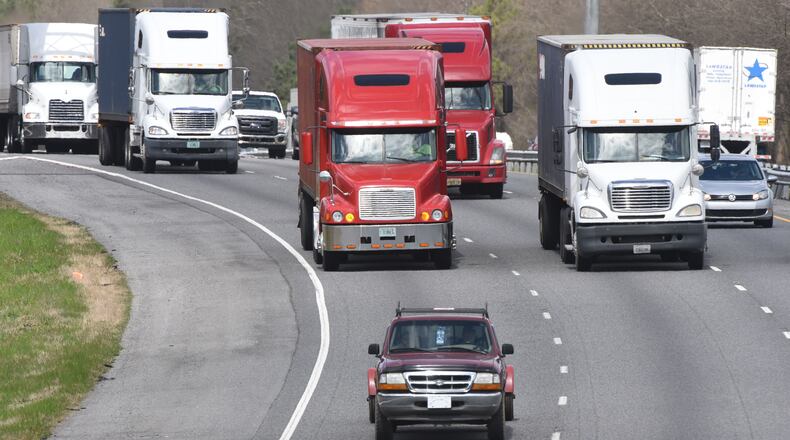Despite some improvement, Georgia doesn’t do enough to ensure that billions of dollars’ worth of road projects are justified, a new audit has found.
The Georgia Department of Transportation has no standard criteria for selecting potential projects, the audit found. It does not use cost-benefit analyses to compare and prioritize projects for funding. And it has done little to improve communication with local officials, who believe political influence plays a big role in which projects make the cut.
GDOT has taken some steps to improve its selection process since the issues were first raised in an audit nearly three years ago, the new report by the Georgia Department of Audits and Accounts found. But the latest review — released this month — found "most findings from our 2016 audit remain unaddressed."
The findings come as GDOT is preparing to spend billions of dollars on major road projects across metro Atlanta — including a network of toll lanes along the Perimeter and on Ga. 400.
GDOT Planning Director Jay Roberts, whose division makes the decisions that have come under scrutiny, welcomed the audit but disagreed with many of its findings. He said the department strives to ensure the best projects move forward.
“This is an important process,” Roberts said. “We want to get better every day.”
One critic says the agency isn’t doing enough to ensure taxpayer money is well spent.
“We’re three years later, and we’re still largely in the same place, in terms of not having any transparency about why we’re choosing the projects that we are and why we’re prioritizing them the way we are,” said Brian Gist, an attorney with the Southern Environmental Law Center.
Auditors conducted the 2016 review at the request of state lawmakers. They examined GDOT's handling of hundreds of projects designed to alleviate traffic congestion. They found GDOT's initial project-screening process is not transparent enough and relies too little on objective criteria.
After the initial screening, GDOT uses a scoring process to prioritize projects for funding. But auditors found the scoring method and criteria to be “problematic.”
One example cited in the original audit: a $2 billion plan to build 40 miles of trucks-only lanes on I-75 south of Atlanta. GDOT selected the project without conducting a cost-benefit analysis to see whether it was worth it.
A 2008 study found the lanes might be a good investment, but it made no recommendation. After GDOT selected the project, a consultant estimated the new truck lanes would reduce vehicle hours of delay along the route by 40%.
GDOT said the decision was just an initial screening — not a final determination that the project would be built. Nonetheless, then-Gov. Nathan Deal included it in a 10-year, $10 billion transportation plan announced three years ago. It is tentatively scheduled for construction beginning in 2025.
The original audit also surveyed dozens of local officials across the state. They believed political influence played a significant role in determining which projects moved forward.
In this month's follow-up report, auditors found GDOT has taken several steps to improve its selection process. For example, it has refined the scoring method used to prioritize projects once they're selected. And it has revised scoring criteria to align with GDOT's strategic goals.
But GDOT has not addressed most of the original audit’s recommendations. The report found GDOT’s planning division “still lacks comprehensive policies and procedures to guide project selection and prioritization decisions and ensure consistency.” And it found the agency has not taken steps to communicate its methods to various groups, including local officials.
In its formal response to the audit, GDOT said it “has made several revisions that have resulted in improvements to the selection and prioritization of (road) capacity projects” and “has implemented the recommendations determined to enhance the existing process.”
It also said it intends to better document its processes and evaluate its prioritization criteria. But it disagreed with other findings.
Roberts said it makes no sense to use data to score every project for initial screenings because the agency won’t move forward with many of those projects. He said the federal government will require a detailed analysis of each project later in the funding process.
And Roberts said “you can’t base everything on cost-benefit.”
One example he cited: the top end of I-285, where GDOT is preparing to spend $4.6 billion to build two toll lanes in each direction between Paces Ferry Road in Cobb County and Henderson Road in DeKalb County. He said the project might not fare well in a cost-benefit analysis because of its substantial right-of-way costs — GDOT expects to buy or obtain easements for about 300 parcels.
“But everybody knows on 285 we need more capacity,” Roberts said.
Gist also cited the I-285 toll lanes — but as a cautionary tale.
“Everyone who uses 285 on a daily basis acknowledges there’s a problem there,” he said. “What we don’t have is how (the toll lanes plan) would compare with other things we could do in that corridor,” such as transit or building one toll lane in each direction instead of two.
“The value of having objective measures, the purpose of that is to help the public understand why we have a problem, how a particular project will fix it and how it compares to all the other options we have in that corridor,” Gist said.
About the Author
Keep Reading
The Latest
Featured





